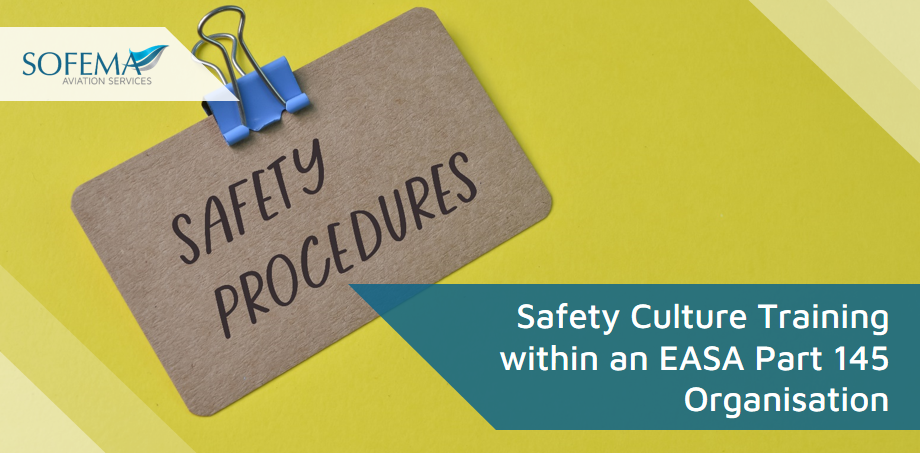Sofema Aviation Services (SAS) www.sassofia.com considers the challenges organisations face when addressing safety culture as part of the EASA Part 145 Organisations SMS
Introduction
Safety Culture Training is a crucial component of the Safety Management System (SMS) within an EASA Part 145 organisation. Part 145 organisations are responsible for the maintenance of aircraft and aircraft components, ensuring they are safe and airworthy.
Developing a strong safety culture through effective training within an EASA Part 145 organisation is challenging but essential. By addressing the diverse needs of the workforce, overcoming resistance to change, allocating sufficient resources, and integrating training into the broader SMS, organisations can foster a culture that prioritizes safety and continuous improvement. This, in turn, enhances operational safety, regulatory compliance, and overall organisational resilience.
Understanding Safety Culture
- Safety culture refers to the shared attitudes, values, norms, and practices regarding safety within an organisation.
- It influences how safety is perceived, prioritized, and executed by all employees. A strong safety culture ensures that safety is an integral part of daily operations and decision-making processes.
Challenges in Safety Culture Training
- Diverse Workforce: The workforce in a Part 145 organisation is diverse, with employees coming from different cultural, educational, and professional backgrounds.
>> This diversity can lead to varying perceptions of safety and its importance.
- Different Levels of Experience: Employees range from highly experienced technicians to new recruits.
>> Tailoring training to meet the needs of this diverse group can be challenging.
- Established Practices (Norms): Long-standing employees may be resistant to changing established practices, especially if they have not encountered significant safety issues in the past.
- Fear of Repercussions: Employees might fear that reporting safety concerns could lead to negative consequences, such as disciplinary action, creating reluctance to embrace new safety protocols.
- Resource Constraints: Effective training requires time, which can be scarce due to operational demands.
>> Finding the balance between maintaining operations and allowing time for comprehensive training is challenging.
- Budget: Allocating a sufficient budget for training programs, materials, and qualified trainers can be difficult, particularly for smaller organisations.
- Effectiveness: Measuring the effectiveness of safety culture training is complex. It’s challenging to quantify changes in attitudes and behaviours and to link them directly to training programs.
- Feedback Mechanisms: Developing effective feedback mechanisms to continually improve training programs can be resource-intensive.
Integration with SMS:
- Holistic Approach: Integrating safety culture training into the broader SMS requires a holistic approach. Ensuring that safety culture principles are consistently applied across all levels and departments of the organisation is challenging.
- Continuous Improvement: Safety culture is not static. It requires continuous monitoring and improvement, which necessitates ongoing training and adaptation.
>> Implement robust mechanisms to measure the effectiveness of training programs, such as surveys, audits, and performance metrics.
Strategies to Overcome Challenges:
- Develop training programs that are tailored to different employee groups, considering their background, experience, and specific roles within the organisation.
- Use a mix of training methods, including classroom instruction, e-learning, workshops, and practical exercises, to cater to different learning styles.
Leadership and Engagement:
- Ensure that leadership is visibly committed to safety culture.
>> Leaders should model safe behaviours and actively participate in safety initiatives.
- Encourage open communication and feedback, ensuring employees feel safe to report concerns without fear of reprisal.
Resource Allocation:
- Prioritize safety training in the budget and allocate dedicated time for training sessions, even if it means adjusting operational schedules.
Integration into Daily Operations:
- Embed safety culture principles into daily operations through regular safety briefings, toolbox talks, and inclusion in performance appraisals.
- Ensure that safety culture training is not a one-time event but a continuous process that evolves with the organisation’s needs.
Next Steps
Follow this link to our Library to find & download related documents for Free.
Sofema Aviation Services and Sofema Online provide Training for Trainers to support organisations wishing to develop EASA-compliant internal Part 145 Initial and Recurrent Training. Please see the websites or email team@sassofia.com.
Tags:
Safety Management System SMS, Aviation Leadership, EASA Part 145 Organisation, SAS blogs, engagement, continuous improvement, Safety Culture Training, Diverse Workforce, Established Practices, Effectiveness, Daily Operations




